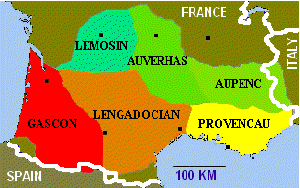The Counts of Toulouse and the Cross of Toulouse: Occitan: the Relationship with Provençal and other Dialects.
As in other parts of the Roman Empire, Vulgar Latin was heavily influenced by local languages.
This accounts for the differences between for example Italian, Spanish, Portuguese, French and Romanian.
It also helps explain the existence of different dialects of Occitan.


A number of Occitan dialects survive, including:
- Limousin (Limosin or Lemosin)
- Auvernhat (Auvernhas)
- Alpine (Aupenc or Vivaro-Alpine)
- Gascon
- Languedocien (Lengadocian)
- Provençal (Provencau)
- Catalan (though this more usually regarded as a separate language)
They can be divided in three main groups: Northern (Limousin,
Auvernhat, Alpine) shown in shades of green; Southern (Languedocien
Provençal, shown in orange and yellow respectively); and
Gascon, shown in red.
The picture is slightly confused by the fact that the literary
form of Occitan was also generally referred to as Provençal. Between
the 12th to 14th centuries, this was a standard literary
language in what is now southern France, northern Spain
and northern Italy. It was widely used in poetry
and was the primary language of the troubadours.
Occitan literature is therefor plentiful. Provençal
was still the leading literary language of Europe when Dante
wrote his Divine Comedy. It was therefore something of a
surprise that he chose to write it in the obscure vulgar
dialect that we now recognise as the precurser of modern
Italian.
Lengadocian and Provençal
Lengadocian is the most conservative dialect
which largely explains why it has became the root of standard
normalized Occitan. Some characteristics are:
- V is pronounced B as in Spanish and Catalan. Eg Vida is pronounced [bido].
- In Southern Lengadocian final -CH becomes -IT. Hence fach (done) becomes fait.
- Eastern Lengadocian is close to Provençal - see below.
Provençal became differentiated from Lengadocian only in the 16th Century . This helps explain why
the word Provençal is often used instead of Occitan. Some characteristics are:
- V is pronounced as in English. Vida is pronounced [vido] or [vid].
- Final -L and -LH become -U. Provençal becomes Provençau
[Proovenssaw]; cèl (sky) is cèu.
- R is not rolled; it is mainly pronounced the French (Parisian) way.
- Final consonants are not pronounced. Parlar (to
speak), parlat (spoken) are pronounced [parlà].
- Extensive nasalization: pan (bread) is [pã].
- Open o (ò) often diphthongizes in [wò], except
in the Rhone region. Eg: Bòn (good) is pronounced [bwòn].
Provençal is famous through the work of poets such as Frederic
Mistral. Mistral wrote in his own dialect (the Southern
Rhone dialect), using of a special spelling ( gràfia mistralenca).
This spelling is not far from standardized Occitan and is
the one used to write place names in Provence. Gascon
Like Castilian Spanish, Gascon was influenced by the Basque language. This explains
the majority of its oddities. Some characteristics are:
- V is pronounced B, as in Castillian and Catalan.
- Initial F- becomes H. Thus, filha (girl) becomes
hilha [hilyo]. Compare with Spanish hija!.
- Final -LL becomes -TH (pronounced -t', -tch,...).
Latin aucell(u) -> ausèth.
- Intervocalic -LL- becomes -R. Bella -> bèra.
- As in Provençal, final -L becomes -U.
- Intervocalic -N- disappears. Una (one) becomes ua.
- Initial R- often becomes ARR-. Riu (river)
becomes arriu. Compare with Spanish rio/arroyo!.
- QU- and GU- are pronounced [kw] and [gw].
- Common metathesis of -R-. Languedocian cambra
(room) becomes cramba.
Northern Occitan (Lemosin, Auvernhat, Provençal Aupin)
Some characteristics are:
- V is pronounced as in English.
- Northern dialects transform -CA into -CHA and -GA into -JA. Example: cantar (to
sing) becomes chantar; galina (hen) becomes jalina.
- Most final consonants are not pronounced.
- As in Provençal, final -L becomes -U.
- Common aphaeresis (disapppearance of initial vowel): aquò
-> 'quò; una -> 'na, etc.
|
|
 Back to: Occitan and French Back to: Occitan and French
|

|
Next Page: Occitan and Catalan 
|
|
|

